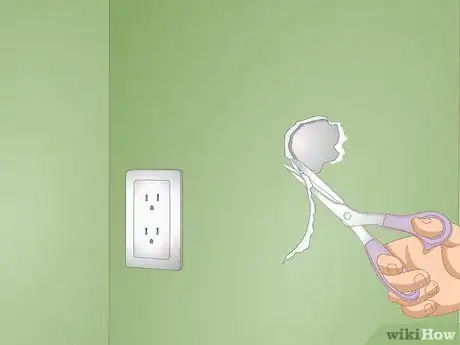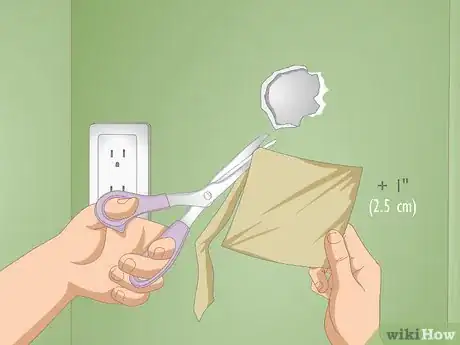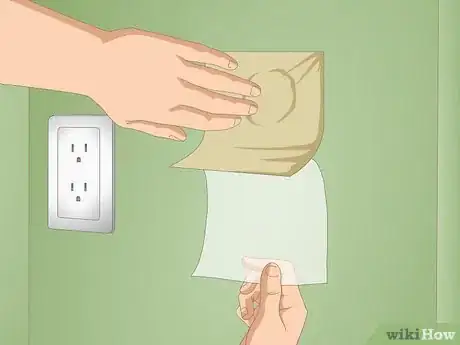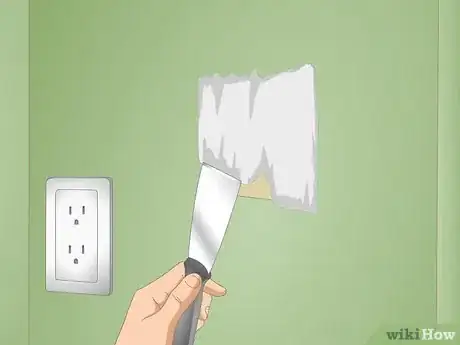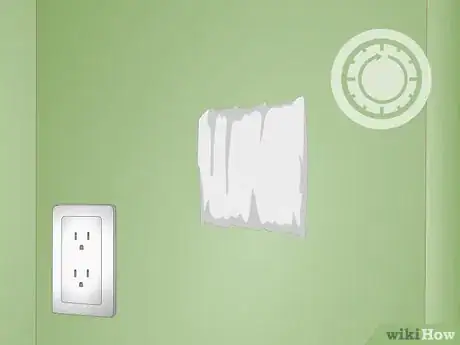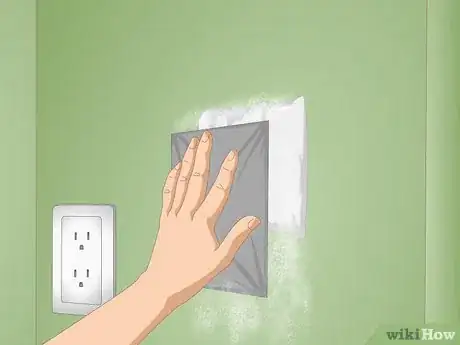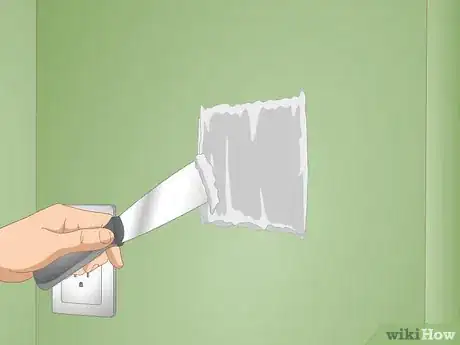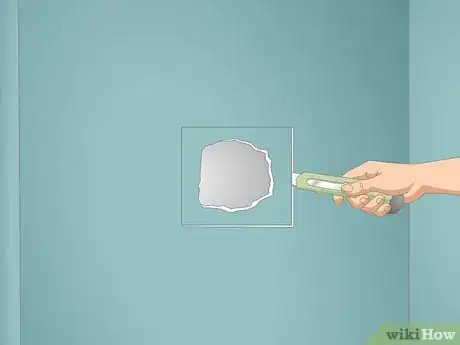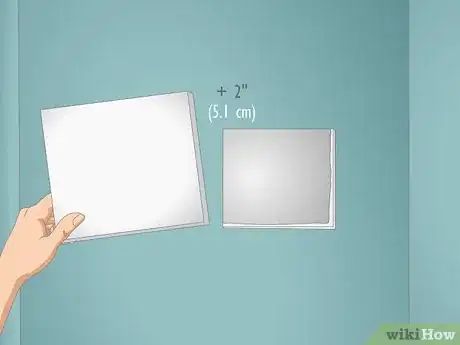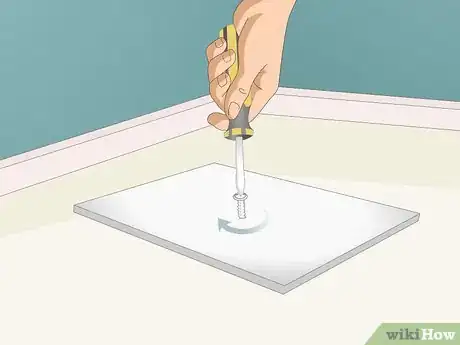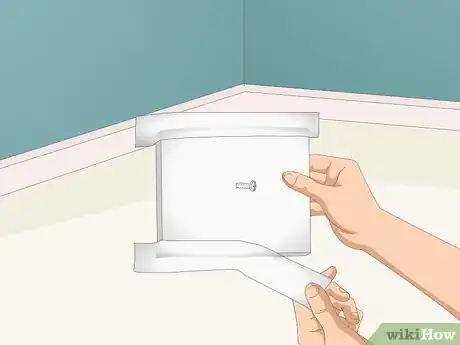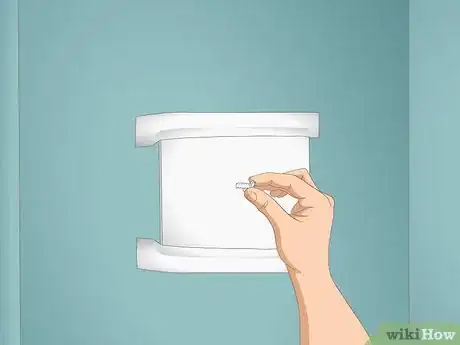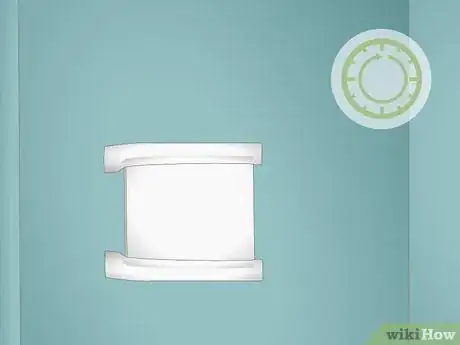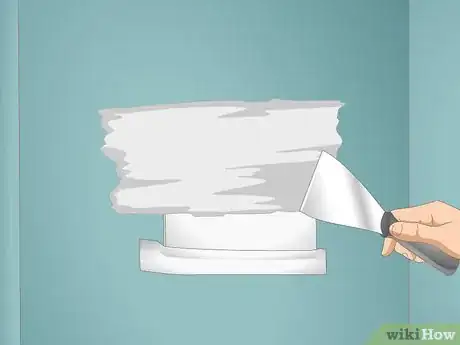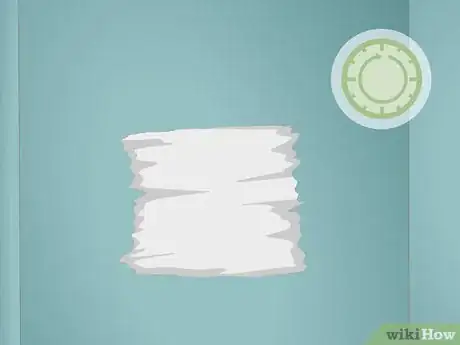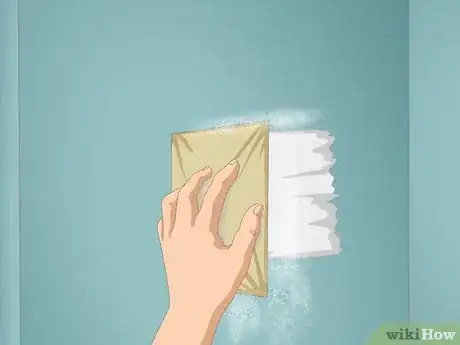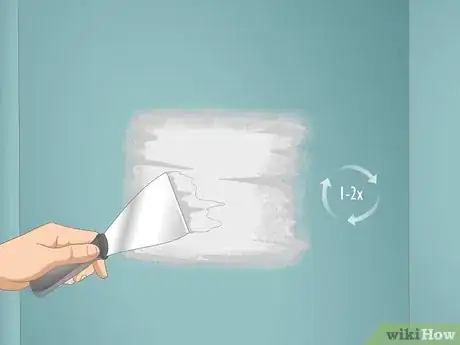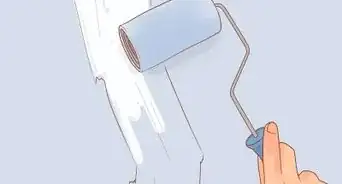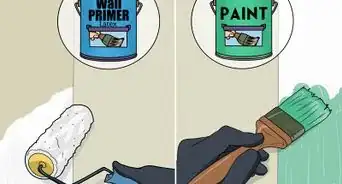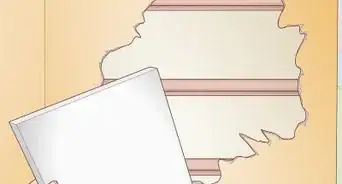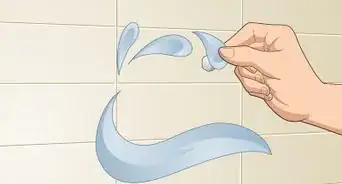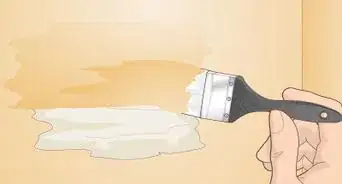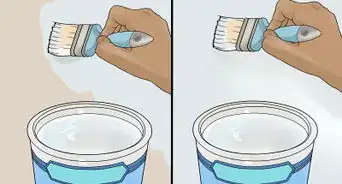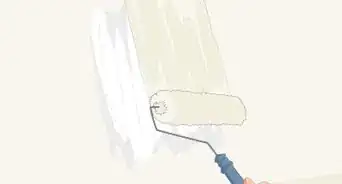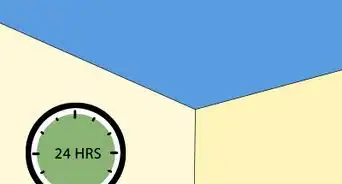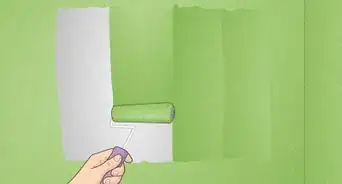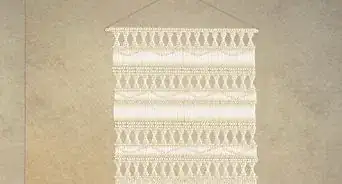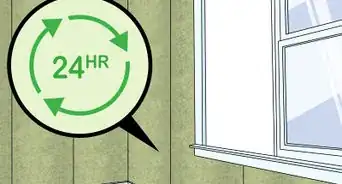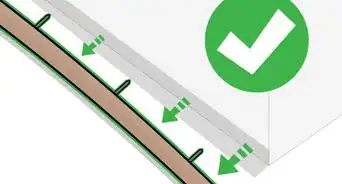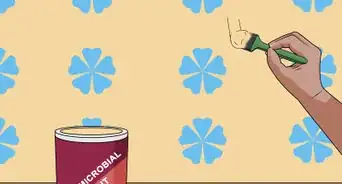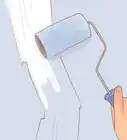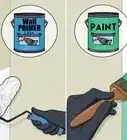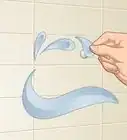This article was co-authored by Agustin Renoj. Agustin Renoj is a Home Improvement Specialist with Renoj Handyman based in the San Francisco Bay Area. With over 18 years of construction experience, Agustin specializes in carpentry, painting, and exterior, interior, kitchen, and bathroom renovations. Renoj Handyman is a family-owned business that consists of craftsmen trained in all areas of construction.
This article has been viewed 36,466 times.
When you have a large hole in your wall, it's easy to patch it up so you can paint over it. Use a wall repair patch to easily cover up holes up to 6 in (15 cm) in diameter. Cut larger holes into a square or rectangle, then create a patch out of drywall and attach it to the inside of the hole. Cover up either type of patch with joint compound and sand it to blend it into the surrounding wall.
Steps
Using a Wall Repair Patch
-
1Cut away and remove any loose debris and jagged paper edges from the hole. Pull off any dangling pieces of drywall and plaster. Use a utility knife to cut along the edges and remove any jagged pieces of drywall paper.[1]
- The goal is to clean the hole up enough that the wall repair patch will sit flat on top of it with no loose debris or ragged paper edges pushing against it or interfering with the adhesive.
- This method works for holes that are up to about 6 in (15 cm) in diameter. Wall patches come in sizes up to 7–8 in (18–20 cm) in diameter, and the patch needs to be slightly bigger than the hole to adhere to the wall around it.
-
2Create a repair patch that is about 1 in (2.5 cm) bigger than the hole. Use sharp scissors to cut a wall repair patch so that it is approximately 1 in (2.5 cm) taller and 1 in (2.5 cm) wider than the hole in the wall. This will allow it to adhere firmly to the intact wall surrounding the hole.[2] [3]
- You can buy wall repair patches in different sizes, so you can also just buy one that is the right size.
- Wall repair patches are made of a mesh material that is able to support spackling on top of it.
Advertisement -
3Peel the backing off the patch and stick it over the hole. Remove the lining from the adhesive on the back of the patch. Center it over the hole and press down firmly around all the sides to stick it to the wall.[4]
- You don’t need to wait for the patch to dry on the wall, the adhesive patch will be sealed and ready to cover up as soon as you stick it on.
-
4Apply a thin layer of joint compound to completely cover the patch. Use a putty knife to spread a layer of joint compound over the entire patch so you can’t see the mesh anymore.[5] Overlap the coat onto the surrounding wall by about 1 in (2.5 cm).[6]
- Overlapping the joint compound onto the surrounding wall will make it easier to blend in so the patch isn’t noticeable.
Tip: Joint compound is also known as drywall mud or just mud.
-
5Let the joint compound dry for 24 hours. Wait until the compound is completely dry before sanding. This usually takes up to 24 hours, but drying times vary depending on the temperature and humidity.[7]
-
6Sand the patch with fine-grit sandpaper until it is smooth. Attach a piece of 120- to 150-grit sandpaper to a sanding block or just sand by hand. Lightly sand the entire patch down until it is smooth and blends in with the surrounding wall.[8]
- Don’t sand too hard or you might expose the mesh patch below the compound. Just focus on smoothing out any rough spots and blending it in with the wall.
-
7Repeat the process for a second coat of joint compound. Apply another thin layer of joint compound over the patch and the surrounding wall. Let it dry for 24 hours, then sand it down with fine-grit sandpaper until it is smooth and blends in with the wall.[9]
- If you want to make the joint compound textured, you can dab it with a sponge while it is still wet or use a textured paint roller to apply a final thin layer of watered-down compound.
- If you’re ready to paint the wall, use a water-based primer to prime the patch before applying wall paint.
Patching with a New Piece of Drywall
-
1Cut the hole into a neat square or rectangle. Use a utility knife or drywall saw to cut the jagged hole into a square or rectangle with straight edges.[10] This will allow you to create a precisely-shaped patch for the drywall and install it easily.[11]
- This method works for holes that are bigger than 6 in (15 cm) in diameter.
-
2Create a patch out of drywall that is 2 in (5.1 cm) taller than the hole. Cut a piece of drywall to the same width as, or just slightly wider, than the hole but a full 2 in (5.1 cm) taller. The extra height will allow you to attach it to the inside of the hole with adhesive.[12]
- You can purchase small pieces of drywall for patching that are 2 ft (0.61 m) in diameter.
Tip: If you don’t have a scrap piece of drywall to make a patch out of, you could use a 1⁄2 in (1.3 cm)-thick piece of scrap wood instead.
-
3Put a screw through the middle of the patch to make a handle. Twist or push a 1.5 in (3.8 cm) or 2 in (5.1 cm) drywall screw through the middle of the drywall patch you made so there is still enough sticking up for you to grab onto. This will allow you to hold it against the inside of the hole while you let the adhesive dry.[13]
- If you don’t have a drywall screw you can use a wood screw instead.
-
4Apply construction adhesive to the bottom and top edges of the patch. Put a zig-zag of construction adhesive along the top 1 in (2.5 cm) of the patch. Do the same for the bottom 1 in (2.5 cm).[14]
- For example, you can use a construction adhesive like liquid nails.
-
5Insert the patch into the hole and use the screw to hold it in place while it sets. Pick up the patch by the screw and tilt it until you can insert it into the hole. Straighten it out so it is oriented correctly and pull it towards the inside of the wall so the adhesive makes contact. Hold it in place for about 15 minutes until the adhesive has dried enough to hold it in place.[15]
- You can either push the screw through the patch into the wall void once it has dried or unscrew it and pull it out.
-
6Let the adhesive cure for up to 24 hours before proceeding. Refer to the manufacturer’s instructions for the adhesive you used to get the exact drying time. Leave it to cure in place at least overnight and up to 24 hours.
- This will ensure that the patch is secured strongly in place and will be able to support the weight of joint compound.
-
7Put a thick layer of joint compound on top of the patch to fill it in. Use a putty knife to apply joint compound over the patch until the hole is filled to the level of the wall. Smooth out the edges so the compound overlaps onto the wall by about 1 in (2.5 cm).[16]
- Use the widest putty knife you have to smooth out the edges more easily.
-
8Let the first layer of joint compound dry for 24 hours. Leave the patch to dry for about 24 hours so it is totally cured before sanding. This is especially important since this layer is relatively thick and it will take longer to dry than a thin layer of joint compound.[17]
- If you don’t let the joint compound dry completely, there will be moisture trapped inside that can cause the patch to fall apart.
-
9Sand the joint compound smooth after it is dry. Use 120- to 150-grit sandpaper to smooth out the first layer of joint compound. Sand by hand or using a sanding block.[18]
- Just try to get rid of any rough patches and blend the edges into the surrounding wall. You will be repeating the process, so don’t worry about getting it perfect.
-
10Apply 1-2 additional thin layers of joint compound to blend the patch in. Use a putty knife to apply another thin coat over the patch and the surrounding 1 in (2.5 cm) or so of the wall. Let it dry overnight, then sand it down with 120- to 150-grit sandpaper to smooth it out and blend it in with the wall. Repeat the steps for another layer if you want to blend it in even more.[19]
- If you need to make the joint compound textured to match the rest of the wall, use a textured roller to apply the watered-down compound as the final layer or dab the final layer with a sponge while it is still wet.
- Remember to let the final coat dry for at least 24 hours before priming the patch and painting the wall.
Things You’ll Need
Using a Wall Repair Patch
- Wall repair patch
- Scissors
- Utility knife
- Putty knife
- Joint compound
- Sanding block (optional)
- 120- to 150-grit sandpaper
Patching with a New Piece of Drywall
- Utility knife or drywall saw
- Piece of drywall
- Putty knife
- Joint compound
- Sanding block (optional)
- 120- to 150-grit sandpaper
- Drywall screw or wood screw
- Construction adhesive
References
- ↑ https://www.apartmenttherapy.com/how-to-patch-a-wall-with-fiberglass-mesh-222788
- ↑ Agustin Renoj. Home Improvement Specialist. Expert Interview. 13 January 2021.
- ↑ https://www.businessinsider.com/how-to-repair-a-hole-in-drywall#how-to-patch-and-repair-larger-holes-in-drywall-6
- ↑ https://www.apartmenttherapy.com/how-to-patch-a-wall-with-fiberglass-mesh-222788
- ↑ Agustin Renoj. Home Improvement Specialist. Expert Interview. 13 January 2021.
- ↑ https://www.businessinsider.com/how-to-repair-a-hole-in-drywall#how-to-patch-and-repair-larger-holes-in-drywall-6
- ↑ https://www.apartmenttherapy.com/how-to-patch-a-wall-with-fiberglass-mesh-222788
- ↑ https://www.apartmenttherapy.com/how-to-patch-a-wall-with-fiberglass-mesh-222788
- ↑ https://www.apartmenttherapy.com/how-to-patch-a-wall-with-fiberglass-mesh-222788
- ↑ Agustin Renoj. Home Improvement Specialist. Expert Interview. 13 January 2021.
- ↑ https://www.thisoldhouse.com/ideas/hole-wall-help
- ↑ https://www.diydoctor.org.uk/projects/repair.htm
- ↑ https://www.diydoctor.org.uk/projects/repair.htm
- ↑ https://www.diydoctor.org.uk/projects/repair.htm
- ↑ https://www.diydoctor.org.uk/projects/repair.htm
- ↑ https://www.diydoctor.org.uk/projects/repair.htm
- ↑ https://www.thisoldhouse.com/ideas/hole-wall-help
- ↑ https://www.thisoldhouse.com/ideas/hole-wall-help
- ↑ https://www.thisoldhouse.com/ideas/hole-wall-help
